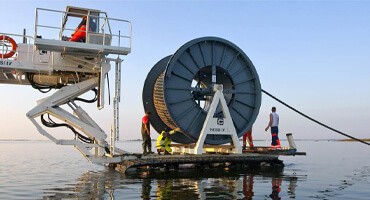In this article, we unravel the world of cable reel slip rings, shedding light on their fundamentals, functionality, variations, and numerous industrial applications. We further discuss how they are installed and maintained, and potential future developments in this technology.
Introduction to Cable Reel Slip Rings
At first glance, cable reel slip rings may appear as simple mechanical devices, but they play a pivotal role in various applications where power, data, or signals need to be transmitted between rotating and stationary components concurrently. They act as the essential conduit that allows for uninterrupted communication, power supply, or data transmission through systems that experience constant rotation or cyclic movement.
Cable reel slip rings or rotary electrical interfaces, as they are technically referred to, consist of rings and brushes that create a continuous and stable electrical connection. Essentially, these components transfer an electrical current from a static part to a rotating part. Whether it’s in the delicate operations of medical scanning devices, the giant turbines harnessing wind energy, or everyday items such as revolving doors or cable drums, slip rings make their operation smooth, efficient, and feasible.
The enduring impact and substantial advantages of cable reel slip rings have consistently changed the dynamics of many industries. Contrary to traditional cable management methods, which often lead to tangling and excessive wear and tear due to rotation, these ingenious devices ensure an orderly, reliable, and safe system of power or signal transmission.
For instance, in the renewable energy sector, the turbine’s rotational movement to generate power makes the use of a static wiring system impractical and risky. Here, cable reel slip rings provide an effective solution by enabling unhindered, bidirectional transfer of power and data, thereby maximizing the potential of such renewable sources.
Moreover, the versatility and adaptability of cable reel slip rings cater to the unique needs of various industry sectors. As a result, they have become an imperative part of not only mechanical engineering, but also aerospace, automation technology, telecommunications, and many more.
Indeed, the humble cable reel slip ring has been instrumental in supporting the advancement of multiple industries, underpinning their innovations and enhancements. Their combination of simplicity in design and complexity in functionality truly underscores their importance across varied applications. As such, gaining an in-depth understanding of cable reel slip rings allows us to appreciate their integral role in powering a vast array of rotating equipment we often take for granted.
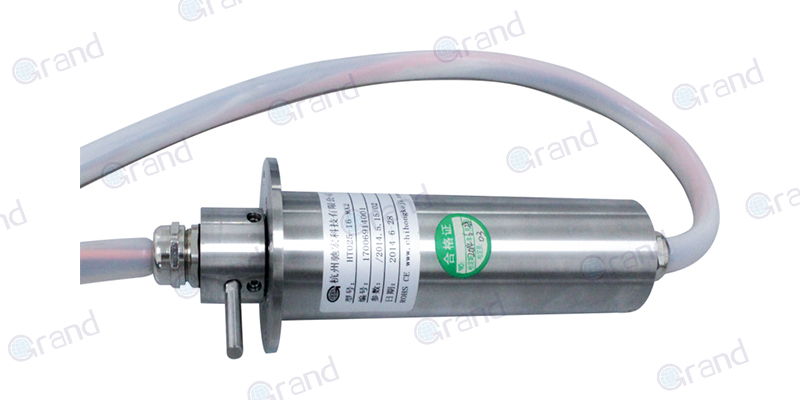
Anatomy of Cable Reel Slip Rings
Cable reel slip rings, often referred to as rotary electrical interfaces, are less simplistic than they appear at first words. They consist of meticulously designed components, each playing an integral role in facilitating smooth and uninterrupted electrical connections between stationary and rotating systems. The key components making up these vital devices are the conductive rings, brushes, and housing—each an engineering marvel in its own right.
The conductive rings—or slip rings—are typically made from highly conductive metals such as gold, silver, or copper, ensuring optimal conductivity. As the central part of a cable reel slip ring assembly, these rings form a continuous, electrically conductive circular pathway. Their primary function is to facilitate an electrical connection between the stationary and rotating parts of a system. Depending on the specific requirements of the system, asymmetrically sliced rings or even stacked rings are sometimes used to handle multiple electrical circuits.
Supplementing the conductive rings are the brushes. These contact elements, typically crafted from graphite or precious metals, glide on the rotating surfaces of the rings to maintain a steady electrical connection. The brushes are mounted onto spring-loaded arms, exerting just the right amount of pressure to maintain contact while reducing wear and tear. It’s a fine balance—too little pressure, and the electrical connection might be unstable; too much pressure and the components could wear out more quickly.
Finally, there’s the housing—often overlooked, but a component just as essential. Its primary function is to not only physically support and protect the delicate inner workings but also to guard against environmental factors. Whether it’s contaminants such as dust or corrosives or electrical hazards such as potential short-circuiting, the housing ensures the slip ring assembly can operate safely and smoothly. It’s designed to be durable while also ensuring efficient heat dissipation, crucial in systems with higher power or speed requirements.
The interaction between these components is a precisely orchestrated mechanical dance. As the part connected to the rotating device turns, the attached conductive rings also rotate, maintaining a circular path. Simultaneously, the brushes—connected to the stationary component—remain in constant moving contact with the rings, picking up the electrical signals or power and transferring it consistently to or from the rotary device. All the while, the housing stays steady, protecting the rings and brushes from external elements, enduring the rigors of varying environmental conditions, and maintaining the integrity of the slip ring system.
A harmonious interaction between these components is crucial for the efficient working of a cable reel slip ring—each part has its role, and every role is pivotal. From the macro perspective of the overall system to the micro precision of individual parts, every detail contributes to the elegant functionality of cable reel slip rings.
Types and Variations of Cable Reel Slip Rings
Cable reel slip rings are diverse in their designs and constructions to cater to various applications in various fields. The sophistication and advancement of these rotary electrical interfaces have led to their categorization into several different types—mainly electrical, pneumatic, hydraulic, and fiber-optic. Each type sports unique characteristics, encapsulating specific advantages, drawbacks, and applicable industrial domains.
Electrical Slip Rings
Electrical slip rings are the most common variety and serve as the foundation upon which other types have been developed. They facilitate electrical connectivity between a fixed structure and a rotating component. Available in various configurations and sizes, these devices cater to a wide range of power and signal transmission needs.
The main advantage of electrical slip rings lies in their ability to transmit diverse types of signals and power, be it AC, DC, RF, or digital signals, consistently even under continual rotation. They’re found in a wide spectrum of applications, including wind turbines, CCTV systems, medical imaging devices, and manufacturing equipment. However, their disadvantage could be the limited bandwidth in high-frequency signal transmission and the possibility of electrical noise in signals.
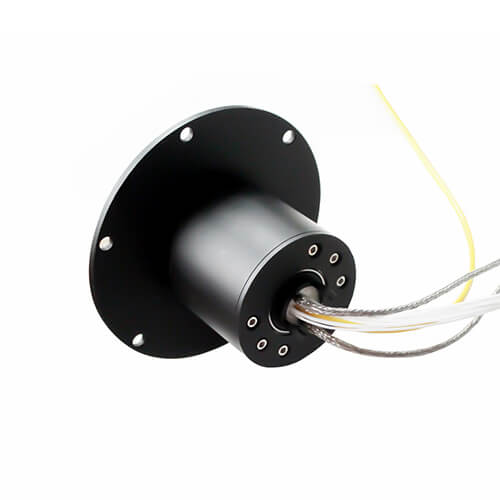
Pneumatic Slip Rings
Also known as rotary unions or rotating joints, pneumatic slip rings are designed for systems that require the transfer of gas or air pressure between stationary and rotating parts. They generally house both an electrical slip ring and a pneumatic rotary joint, making them ideal for applications that require simultaneous power and air transfer.
Pneumatic slip rings are commonly found in automated machinery, robotics, and packaging equipment. Their crucial advantage is the ability to transmit gases under rotation, but on the downside, they require proper sealing to prevent leaks and can be complex to maintain due to the gas transmission component.
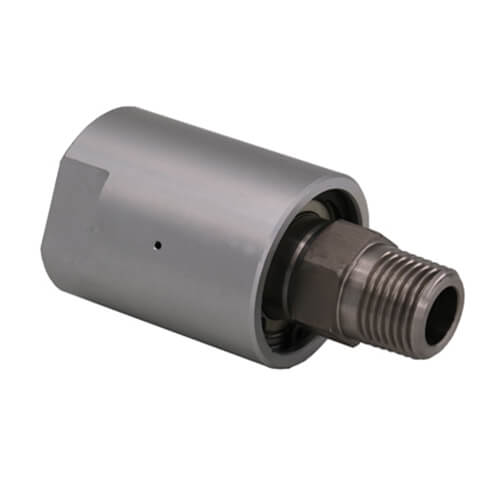
Hydraulic Slip Rings
Similar to pneumatic slip rings but designed for liquid media, hydraulic slip rings or hydraulic rotary unions facilitate the transfer of fluids between rotating and fixed components. They can also contain an electrical slip ring for simultaneous power and fluid transmission.
Industries that often use hydraulic slip rings include oil and gas, marine, and other fields where fluid movement is necessary in a rotating system. The advantage is their ability to handle high-pressure fluid transfer; however, their maintenance can be demanding, and any leakage can lead to significant operational issues.
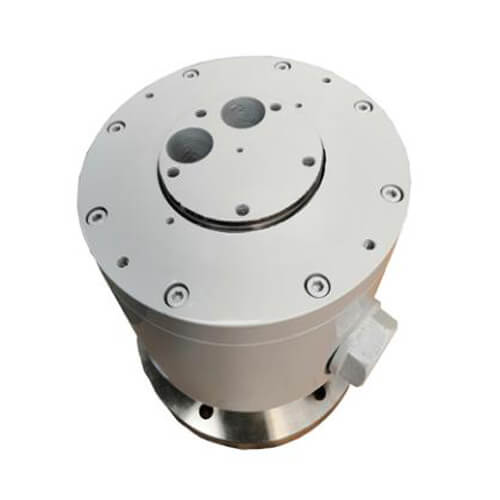
Fiber Optic Rotary Joints (FORJs)
For applications that demand high-speed data transmission and immunity from electromagnetic interference, fiber-optic slip rings (also known as FORJs, Fiber Optic Rotary Joints) come into play. They use light as a medium for signal transmission and maintain optical connectivity between rotating and stationary interfaces.
These slip rings are exceptionally beneficial in high-tech sectors such as telecom, defense, and aerospace, where high-speed, high-bandwidth, and noise-free transmission is crucial. However, their complexity and the need for precision alignment could make them expensive and relatively fragile compared to other types.
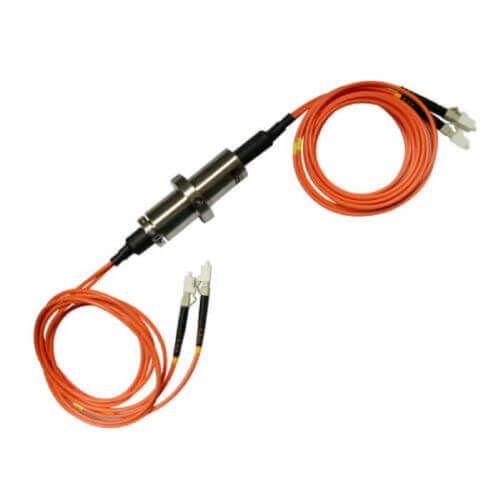
In conclusion, each type of cable reel slip ring has its unique features and serves distinct application scenarios. The selection depends primarily on understanding the specific requirements of the application and considering the advantages and potential drawbacks each type presents. Choosing the right type can significantly impact the efficiency, safety, and operational longevity of your equipment.
Cable Reel Slip Rings Operating Mechanism and Technical Concepts
Understanding the operating mechanism of cable reel slip rings and the associated technical concepts provides a comprehensive insight into their significance in diverse applications requiring continuous power or signal transmission, despite rotational movement.
Cable reel slip rings function based on a simple but ingenious principle. At their core, they establish an electrical connection between a stationary and a rotating component in a system. The conductive rings attached to the rotating part maintain a continuous circuit — even as they rotate — while the static brushes slide on the ring surfaces and pick up or pass on the electrical power or signals. It’s a delicate dance that enables continuous transmission without interfering with the mechanical motion of the equipment involved.
Now, this basic operating mechanism integrates critical technical parameters that directly impact the performance and efficiency of these devices. Key among these technical concepts are rotational speed, transmission media, and contact materials.
- Rotational Speed: Rotational speed, typically measured in revolutions per minute (RPM), is an important factor in slip ring design. It refers to how fast the slip ring or the equipment it’s attached to is spinning. Higher rotational speeds generally pose greater challenges in maintaining steady electrical contact. Thus, the design of both the conductive rings and brushes should factor in the rotational speed to ensure effective and consistent transmission and to minimize wear and tear.
- Transmission Media: The transmission media determine the type of data or power that the slip rings can handle. For instance, electrical slip rings generally work with a range of transmission media, including DC, AC, RF, and digital signals. On the other hand, pneumatic and hydraulic slip rings are designed to handle air or fluid, respectively. Fiber-optic slip rings specialize in high-bandwidth data transmission using optical fibers. The selection of slip rings depends on understanding the specific media to be transferred.
- Contact Materials: The choice of contact materials — those used for the conductive rings and brushes — can significantly impact the performance of the slip rings. Materials with high conductivity, such as gold, silver, or copper, are often used for the conductive rings. The brushes, on the other hand, are typically crafted from graphite or precious metals, designed to slide smoothly on the ring surfaces. The choice of these materials can influence factors such as electrical noise, signal quality, and the lifespan of the slip ring.
In conclusion, it’s a combination of these nuanced technical elements and the symbiotic interplay between the slip rings’ primary components that establish an effective cable reel slip ring system. Designed to withstand challenging operational conditions, these marvels of engineering continue to impact a versatile range of industries, facilitating continuous power or signal transmission amidst constant rotational movement.
Cable Reel Slip Rings Industry-specific Applications
Owing to their ingenious design and functionality, cable reel slip rings find their applications across a wide range of industries, from power generation to broadcasting, and automation. Let’s dive into the details of their significance in these sectors with some specific industry examples.
- Energy Industry: In wind turbines, cable reel slip rings play a crucial role. The wind causes the turbine blades to rotate — consequently requiring the generator and control system (stationary components) to be electrically connected with the rotating parts. By integrating electrical slip rings, the wind turbine can transmit generated power and operational data continuously despite the rotational movement.
- Broadcast Industry: In the realm of broadcasting, particularly in television studios, cable reel slip rings make their mark. Cameras often rotate or pan to capture different angles, and maintaining constant power and signal transmission during these maneuvers is essential. Fiber-optic slip rings provide high-speed data transmission, ensuring continuous, high-quality live or recorded broadcasts.
- Automation Industry: Robotic arms and automated machinery are among the most prolific users of cable reel slip rings. For instance, in fully automated bottling plants, pneumatic slip rings transfer air pressure for the actuation of mechanical components that frequently rotate. With the combination of an electrical slip ring, these devices can simultaneously transmit power and control signals, ensuring seamless automation.
- Maritime Industry: Underwater ROVs (Remotely Operated Vehicles) for exploration or repair tasks often require tether management systems (TMS) which utilize a combination of electro-optic slip rings for continuous power supply and high-speed data transmission. These slip rings need to be robust, resistant to high pressure, and offer reliable performance under challenging underwater conditions.
- Defense and Aerospace Industry: In radar systems, electrical slip rings allow antenna systems to rotate continuously at 360 degrees while maintaining an uninterrupted supply of power and data. Similarly, fiber-optic slip rings provide high-bandwidth data connections in complex satellite communication systems while they spin in space.
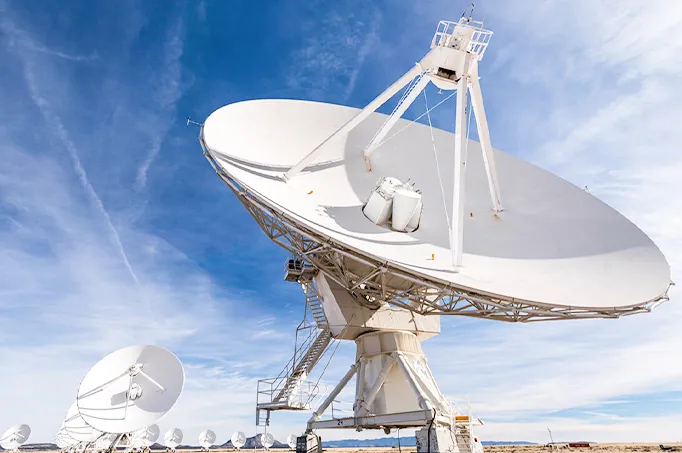
To sum up, a diverse multitude of industries realizes the indispensability of cable reel slip rings in their operational scenarios. Whether it’s harnessing wind energy, real-time broadcasting, automating industrial processes, or enabling defense mechanisms, the applications are myriad and far-reaching. These robust devices prove to be critical elements in numerous applications, enabling continuous transmission of power, signals, or media amidst rotational movement.
Cable Reel Slip Rings Installation and Integration
Implementing cable reel slip rings into an application or existing system demands not only a proper understanding of the installation process but also a well-informed approach toward integration with other components. This ensures smooth operation and a longer lifespan for the slip ring and the entire system.
Installation Process
The typical installation process for cable reel slip rings involves preparation, mounting, and electrical connection of the device. Here’s a step-by-step overview:
- Step 1: Preparation: Before installation, gather all necessary tools and materials. This includes the slip ring, mounting hardware (such as screws, bolts, or clamps), and the electrical cables that will connect to your system. Unpack the slip ring and review the accompanying documentation for specific instructions as well as torque, temperature, and environmental specifications.
- Step 2: Mounting: Begin by assembling and installing the stationary component (the base) to a suitable and secure surface according to the manufacturer’s guidelines. This may involve bolting or clamping it in place. Next, mount the rotating component to the corresponding rotating equipment, ensuring that the installation is secure and the slip ring and rotating equipment are properly aligned.
- Step 3: Electrical Connection: Once mounted, route the cabling from your stationary system components to the stationary part of the slip ring. Ensure the cables are tightly fastened to the specific terminal points — as per the documentation or wiring diagram. Similarly, connect the rotating element cables to the corresponding rotating equipment’s electrical points. Make sure the cables are secure and correctly connected.
Before powering on your equipment, double-check all connections. It’s also advisable to perform rotation tests at this stage to ensure that no interferences or issues are observed before finalizing the installation process.
Integration with Existing Systems
Effectively integrating cable reel slip rings into an existing system depends on several considerations and guidelines, as listed below:
- Compatibility: Check the compatibility of the slip ring with your current system requirements. This includes voltage and current ratings, the number of channels and circuits, and rotational speed requirements. Ensure that the selected slip ring meets or exceeds these specifications.
- System Integration: Determine how the slip ring will connect to other system components physically. Account for spatial requirements, available mounting options, and any necessary modifications or additions to the system for successful integration, such as bracketry or adapters.
- Environmental Considerations: Assess the environmental factors and operating conditions, including temperature, humidity, and surrounding materials. Ensure the slip ring is built to resist such conditions and maintain consistent performance despite the environment.
- Maintenance: Plan for regular inspection, cleaning, and maintenance of the slip ring as part of the overall system. This includes checking the brush and ring contact surfaces, lubrication, and other preventive maintenance measures as recommended by the manufacturer.
In conclusion, the proper installation and integration of cable reel slip rings hinge on careful planning, adherence to manufacturer guidelines, and attention to equipment compatibility, environmental factors, and maintenance requirements. By following these general guidelines and understanding the context of the specific application, you can achieve seamless integration of slip rings into your system, bolstering operational efficiency and equipment longevity.
Cable Reel Slip Rings Performance Factors
The performance of cable reel slip rings is deeply influenced by several factors, which span environmental conditions, load capacity, and duty cycle, among others. Understanding these components can guide strategies for optimization, ensuring efficient performance and extended lifespan of the slip ring and overall system.
Performance Factors
Let’s delve into some determinants of cable reel slip ring performance:
- Environmental Conditions: These slip rings’ functionality can be affected by a range of environmental conditions, such as temperature, humidity, and dust levels. For example, extreme cold or heat can impact the conductivity of the materials and general operations. High humidity levels may lead to potential corrosion, while dust can increase wear and tear.
- Load Capacity: The type and amount of load carried by the slip ring also influences its performance. These loads can be electrical (current and voltage levels), data (bandwidth requirements), or fluid (in the case of hydraulic or pneumatic slip rings). Ensuring the slip ring is designed to meet or exceed these load specifications is crucial.
- Duty Cycle: The duty cycle represents the operating pattern of the slip ring. It includes aspects like the frequency of rotations, speed, and intervals of rest. High-speed, continuous rotations can cause faster wear and tear compared to intermittent usage.
- Contact Materials: The choice of materials used for the conductive rings and brushes significantly impacts slip ring performance. Different materials exhibit varying degrees of electrical conductivity, friction coefficients, and durability.
Optimization Tips
Optimization of these performance factors can enhance the efficiency and lifespan of your slip ring. Here are a few practical tips:
- Environmental Adaptation: Choose slip rings designed for the specific environment in which they’ll be used. For instance, go for slip rings crafted with dust and corrosion-resistant materials for dusty or high-humidity settings, or opt for high-temperature-resistant slip rings for high-heat applications.
- Load Management: It is crucial to select a slip ring capable of handling the electrical, data, or fluid loads your system requires. Don’t underestimate the value of investing in slip rings with higher load capacities than your current need, as they offer room for future expansion or unexpected load surges.
- Duty Cycle Management: Regular maintenance, such as cleaning and lubrication, is especially critical in high-duty-cycle applications. Sequencing rotations and rest periods can also prolong the lifespan of the slip ring.
- Select High-quality Materials: Opt for slip rings utilizing high-conductivity contact materials like gold or silver and durable brush materials. Although this might increase initial costs, it can reduce maintenance costs and downtime in the long run.
In conclusion, taking into account these performance factors and employing appropriate optimization strategies can significantly enhance the performance and durability of cable reel slip rings. Whether that’s adapting to the environment, managing the load, and duty cycle, or investing in quality materials, these steps can accompany the slip ring’s seamless integration and utilization.
Cable Reel Slip Rings Troubleshooting and Maintenance Guidelines
As with any mechanical or electrical system, cable reel slip rings can experience issues that may affect their performance over time. Regular maintenance and efficient troubleshooting practices can identify and solve these problems, ensuring smooth operation and longevity.
Common Troubleshooting Procedures
Addressing slip ring issues involves identifying symptoms, determining potential causes, and implementing corrective actions. Below are some common problems and procedures for troubleshooting them:
- Intermittent Signal or Power Loss: If you’re experiencing sporadic signal or power loss, the cause could be a worn-out brush or contact surfaces, misalignment of components, or incomplete connection. This can be resolved by inspecting & repositioning the components, repairing connections, or replacing the worn-out parts.
- Decreased Data Transmission Speed/Quality: If the quality or speed of data transmission declines, it might be due to dust accumulation on the rings or worn-out contact materials. Cleaning the rings and brushes or replacing the contact materials should fix this.
- Overheating: Overheating could result from excessive current/voltage, inadequate heat dissipation, or excessive friction. Lowering the electric load, improving ventilation, or lubricating moving parts can mitigate this issue.
Routine Maintenance Tasks and Their Importance
Regular maintenance keeps a check on wear and tear, extends the lifespan of the slip ring, maintains performance, and helps prevent operational downtime. Here are some basic tasks:
- Regularly Clean: Dust and debris can cause shorts and impede signal quality. Therefore, regular cleaning using a soft brush or compressed air is important to keep the contacts clean.
- Inspect & Lubricate: Regular inspection helps to identify any abnormal conditions before they escalate and compromise the entire system. Additionally, lubricating contact points can reduce wear and tear, following the instructions provided by the manufacturer.
- Checking Connections: Over time, connections can become loose due to vibrations. A routine check for secure connections can avert signal loss or intermittent operation.
- Replace Worn-out Parts: Regular inspection can identify wear and tear early, allowing for timely replacement before a total failure occurs.
In conclusion, keeping cable reel slip rings functioning optimally requires an understanding of common troubleshooting procedures and regular maintenance practices. With a proactive approach – spotting early signs of wear, performing regular cleaning, inspection, and scheduled replacements – you can ensure your slip ring continues to operate efficiently, minimizing downtime and potential operational losses.
Cable Reel Slip Rings Safety Measures and Precautions
Safety is paramount when installing, operating, and maintaining cable reel slip rings. Adhering to industry standards and taking prudent precautions can mitigate risks associated with working with electrical equipment and machinery, preventing injuries and streamlining operations.
Safety Practices
With each unique process – installation, operation, or maintenance – comes unique potential hazards. Let’s consider safety practices for each:
- Installation Safety: Before starting the installation process, it’s essential to power down and isolate any electrical equipment involved. Additionally, confirm the structure where you’re installing the slip ring is stable, and don’t forget to use suitable and certified tools for the job. Also, always follow the instructions outlined by the slip ring manufacturer.
- Operational Safety: During operation, ensure that the area around the slip ring is kept clear of obstructions or loose items, as these may potentially interfere with its rotation. It’s also crucial to stick to the designated load limits to prevent overheating or mechanical failure.
- Maintenance Safety: Before performing maintenance tasks, power down the equipment and use appropriate personal protective equipment (PPE), such as gloves and safety glasses, to protect against electrical shock or accidental contact with harmful substances. Moreover, use non-conductive tools during the cleaning and inspection to avoid electric shock occurrences.
Health and Safety Protections
When managing slip rings, it’s prudent to account for both health and safety protections. These measures not only safeguard equipment users and maintenance staff but also promote optimal machine performance:
- Personal Protective Equipment (PPE): Always ensure that the right PPE is used during all procedures. This may include electrical-insulating gloves, safety eyewear, protective clothing, and insulated tools.
- Proper Training: Ensure all personnel involved in the installation, operation, and maintenance of slip rings receive comprehensive training regarding the handling, common issues, troubleshooting, and safety measures pertinent to the equipment.
- Safety Compliances: Adhering to local safety regulations and industry standards is key. Ensure the slip ring and associated equipment meet necessary safety certifications and guidelines.
- Clear Communication: Establish clear guidelines and procedures for emergencies, including potential electrical failures or accidents. Signage around the working area can help remind users of the necessary safety precautions.
In conclusion, safety measures and precautions are fundamental in handling cable reel slip rings. From ensuring correct PPE to giving proper training, and enabling clear communication, these practices safeguard personnel and promote efficient operation of the equipment. By adhering to these precautions, potential risks related to the installation, operation, and maintenance of slip rings can be significantly mitigated.
Innovations and Future Trends of Cable Reel Slip Rings
As with any other field in the tech industry, the evolution of cable reel slip rings continues through constant innovation and development. These advancements aim to boost efficiency, reliability, durability, and adaptability, providing solutions that match the dynamic needs of different industries.
Current Innovations and Improvements
Several recent advancements in the field of cable reel slip rings have improved their performance and expanded their capabilities:
- Material Innovations: Contact and brush materials greatly influence slip ring performance. Innovations in this sector include the use of precious metals or advanced conductive composites which offer superior conductivity, reduced friction, and enhanced wear resistance.
- Design Improvements: Innovative designs, such as modular and pancake slip rings, provide compact and low-profile solutions that can be easily integrated into space-constrained applications.
- Fiber-Optic Rotatory Joints (FORJs): In applications where high-speed data transmission is necessary, FORJs are integrated into slip rings to facilitate the transfer of optical signals effectively.
Potential Future Developments
Looking ahead, several emerging trends could potentially reshape the world of cable reel slip rings:
- IoT Integration: The Internet of Things (IoT) is becoming an integral part of many industrial processes. In the future, slip rings may incorporate IoT capabilities to enable remote condition monitoring, predictive maintenance, and seamless integration with other connected devices.
- AI-Assisted Operation: Artificial intelligence could enhance diagnostics and troubleshooting, predicting and addressing issues before they disrupt operations.
- Green and Sustainable Solutions: With the increasing emphasis on sustainability and energy-efficient solutions, we can expect the development of slip rings with lower power losses, higher efficiency, and environmentally friendly materials.
In conclusion, the world of cable reel slip rings is ever-evolving, with new improvements and innovations emerging regularly. From developing new materials and designs to integrating advanced technologies such as IoT and AI, these advancements aim to boost the performance, reliability, and capabilities of slip rings to meet the needs of various applications. While we cannot predict the future precisely, these trends provide exciting clues as to the direction this technology is headed.
Conclusion
Understanding the features, best practices, and safety measures associated with cable reel slip rings is vital. As technology advances, these components continue to evolve, offering innovative solutions to the industry’s challenges. Here’s to harnessing the full potential of cable reel slip rings for your specific requirements.
FAQs about Cable Reel Slip Rings
Q: What is a Cable Reel Slip Ring?
A: A cable reel slip ring is a device that enables the transmission of power and data between a stationary and a rotating structure. It’s typically used in applications where continual rotation is needed, and the traditional wiring system is not capable.
Q: Why is My Slip Ring Overheating?
A: Overheating is common when slip rings are overloaded or lack adequate ventilation. Inspect the load capacity, check for proper ventilation, ensure the contact materials aren’t worn out, and make sure your slip ring is lubricated appropriately.
Q: Why is Signal Transmission Poor?
A: Poor signal transmission may be due to dust or debris on contact surfaces or worn-out brushes. Regularly clean your slip ring and replace the brushes when necessary to boost signal quality.
Q: How Often Should I Maintain My Slip Ring?
A: Maintenance frequency depends on the operating conditions. However, as a general rule, a visual inspection can be performed monthly, while more thorough maintenance (cleaning, checking connections, lubrication) may be carried out every six months to a year.
Q: Which Slip Ring Should I Choose?
A: The best choice of a slip ring depends on various factors, including the type and number of signals, rotational speed, load capacity, and environmental conditions you will be operating under. Consult your manufacturer or supplier for the best advice.
Q: Can Slip Rings Transmit Data In Addition to Power?
A: Yes, the modern slip rings are capable of transmitting multiple types of signals, including data, alongside power. Specialty slip rings can even handle very high-speed data signals using Fiber Optics technology.
See What We Can Do

